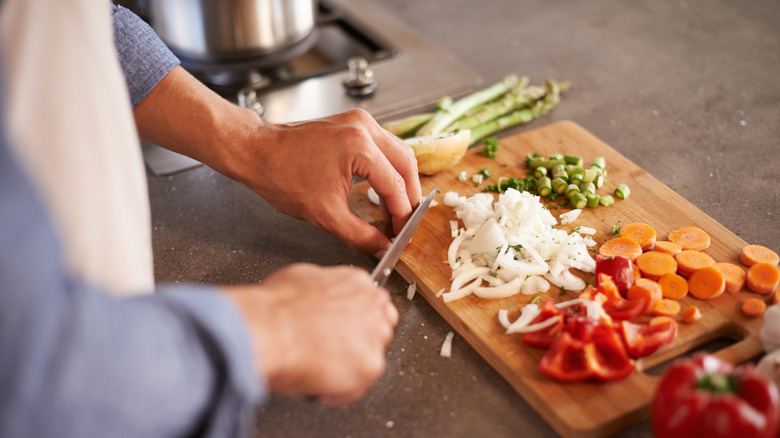Keeping your kitchen tools clean, especially a chef knife, is a must for maintaining their efficiency and extending their life. For both home cooks and professional chefs, learning how to clean chef knife properly is essential for food safety and blade durability. In this article, we are delighted to share some big and approved cleaning techniques to keep your favorite kitchen tool spotless and razor-sharp.
Follow along as we break down step-by-step instructions for cleaning, drying, and maintaining your cherished chef knife. Whether you’re refining your culinary skills or ensuring hygienic meal prep, these cleaning tips will provide tremendous help every time.

Why Proper Knife Cleaning Is So Important?
A chef knife is an investment, and proper maintenance ensures that investment lasts. Cleaning it not only protects the blade and handle but also prevents cross-contamination of foods.
- Food Safety: Residue from raw meat or unwashed vegetables can harbor bacteria.
- Prolongs Longevity: Improper cleaning can result in dull blades and premature wear.
- Aesthetic Maintenance: Keeps your knife looking new and polished.
Tools Youll Need for Cleaning
Before diving into how to clean chef knife, gather these tools:
- Warm Water: Lukewarm water is ideal for loosening grime.
- Dish Soap: A mild soap works best.
- Sponge or Soft Cloth: Avoid abrasive pads to prevent scratches.
- Drying Towel: Use a microfiber towel for drying.
- Optional: Vinegar for deep cleaning and mineral oil for polishing.
Simple Steps for Everyday Cleaning
To keep your chef knife clean after everyday use, here are some approved steps to follow:
1. Rinse Immediately
After using the knife, avoid letting food residue sit for too long. Wash it under lukewarm running water to prevent food from hardening on the surface.
2. Apply Soap
Squirt a small amount of dish soap onto a soft sponge or cloth. Gently scrub the blade and handle, paying extra attention to crevices and grooves.
3. Rinse Thoroughly
Remove all soap residue with clean running water to avoid stains or discoloration.
4. Dry Completely
Use a microfiber towel to wipe off all water. Moisture can lead to rust or mold, especially along the blade’s edge.
Deep-Cleaning for Your Chef Knife
A deep cleaning is recommended if youve been working with sticky ingredients or if your knife hasnt had a proper cleaning in a while.
Step 1: Soak in Vinegar Solution
Create a 3:1 mixture of warm water and white vinegar. Allow the knife to soak for 5-10 minutes. This will help break down any hardened residue and stains.
Step 2: Scrub Gently
Use a soft brush to clean tougher spots, particularly along the knifes edge and bolster.
Step 3: Polish with Oil
After the knife has dried, rub a small amount of mineral oil along the blade to maintain its shine and protect it from discoloration.
Common Mistakes to Avoid
Despite your best intentions, using the wrong cleaning technique can damage your knife. Avoid these pitfalls:
- Skipping Drying: Never leave your knife to air dry, as it invites rust.
- Dishwasher Use: Chef knives should always be hand-washed, as dishwashers can dull the edge and damage the handle.
- Abrasive Materials: Steel brushes or harsh pads can scratch the blade.
Storing Your Chef Knife Properly
Once your knife is clean, proper storage is crucial for keeping it in peak condition.
- Use a magnetic strip for a modern, safe way to store your clean knife.
- Avoid traditional drawers, where knives can knock against other cutlery and dull quickly.
- Consider a wooden knife block for easy access and effective protection.
Handling Stubborn Stains and Rust
Sometimes, despite taking care, your knife may develop stains or even rust spots. Heres how to tackle these issues:
Rust Removal
Apply a paste of baking soda and water to rusted areas and rub gently with a soft cloth. For deep rust, consider using a rust eraser.
Stain Treatment
Clean with lemon juice or an equal mixture of vinegar and water to remove discoloration from acidic foods like tomatoes or citrus fruits.
Conclusion
Cleaning a chef knife doesnt have to be complicated, but it does require attention to detail and consistency. By mastering these steps and avoiding common mistakes, youll enjoy a long-lasting, efficient tool thats always a pleasure to use in the kitchen.
Useful Resources
- Knife cutting methods for enhancing food prep efficiency.
- Discover more about fast vegetable cutting.
- Learn how to cut turkey the right way.

FAQs
1. How often should I clean my chef knife?
You should clean your chef knife immediately after each use. This prevents residue from hardening or causing discoloration.
2. Can I put my chef knife in the dishwasher?
No, dishwashers can dull the blades edge and harm the handle. Always hand-wash your knife.
3. Whats the best way to remove rust stains?
Using a mixture of baking soda and water to gently scrub rust spots is an effective and approved method.
Published on: 2024-01-12
This article contains affiliate links. We may earn a commission at no extra cost to you.


